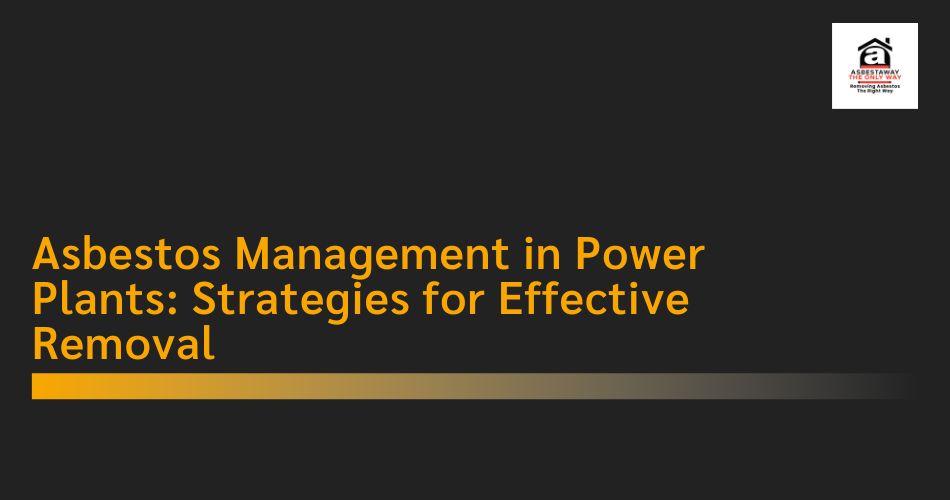Asbestos, once widely regarded as a ‘wonder material’ for its insulation, fire resistance, and durability, has unfortunately left a hazardous legacy in industrial sectors, including power plants. Power plants, particularly older facilities, often contain significant amounts of asbestos, which was used in a variety of ways, including in insulation, flooring, roofing materials, and even equipment linings. However, as research revealed the severe health risks associated with asbestos exposure—ranging from lung cancer and asbestosis to mesothelioma—its use was banned in Australia in 2003.
Despite the ban, asbestos remains a significant concern in Australian power plants, especially those built or refurbished before the ban. As such, managing asbestos safely in these facilities is of utmost importance. Asbestos management in power plants involves identifying asbestos-containing materials (ACMs), assessing potential risks, and implementing appropriate removal strategies to ensure the safety of workers and the surrounding environment.
This blog will explore the strategies for effective asbestos removal in power plants, focusing on the best practices for identifying, managing, and safely removing asbestos in Australian power plants. Additionally, we will look at how companies like Asbestaway can play a pivotal role in the successful management and removal of asbestos from power plants.
The Role of Asbestos in Power Plant Construction
Asbestos in Power Plants: Where It Can Be Found
Asbestos was commonly used in power plants for its fire-resistant properties, insulation capabilities, and overall strength. It was considered an ideal material for environments where high temperatures, fire risks, and energy efficiency were concerns. In power plants, asbestos was typically used in the following areas:
- Insulation Materials: Asbestos was used extensively to insulate boilers, turbines, piping, and other high-temperature equipment in power plants. Its ability to withstand extreme temperatures made it ideal for protecting equipment and preventing heat loss.
- Fireproofing: Asbestos-containing materials were applied to structural steel beams, walls, and ceilings to prevent fires from spreading. In high-risk environments like power plants, fireproofing was a critical safety measure.
- Roofing and Wall Cladding: Asbestos-cement sheets were commonly used for roofing and wall cladding in power plants due to their durability, low cost, and fire-resistant qualities.
- Flooring Materials: Asbestos-containing floor tiles and vinyl flooring were often installed in power plant control rooms, hallways, and other high-traffic areas due to their wear resistance.
- Gaskets and Seals: Asbestos was also used in gaskets, seals, and packing materials for machinery and equipment in power plants. These components were crucial for maintaining airtight seals in piping systems and valves.
Despite its benefits, the use of asbestos in power plants posed a significant long-term risk to workers and anyone exposed to airborne asbestos fibres. Over time, as the materials deteriorate or are disturbed during maintenance and renovation work, asbestos fibres can become airborne, increasing the likelihood of harmful exposure.
The Health Risks of Asbestos Exposure in Power Plants
The Dangers of Asbestos for Power Plant Workers
Asbestos exposure can lead to severe respiratory and health issues, especially for workers in power plants who may come into direct contact with asbestos-containing materials. The primary health risks associated with asbestos exposure in power plants include:
- Asbestosis: Asbestosis is a chronic lung disease caused by inhaling asbestos fibres over an extended period. It results in scarring of the lung tissue, making breathing increasingly difficult. Symptoms of asbestosis include shortness of breath, persistent coughing, and chest pain. In severe cases, it can lead to respiratory failure.
- Lung Cancer: Long-term exposure to asbestos increases the risk of lung cancer, especially in individuals who smoke. Asbestos fibres that are inhaled can become embedded in the lung tissue, leading to the development of cancerous cells over time.
- Mesothelioma: Mesothelioma is an aggressive cancer that affects the lining of the lungs, abdomen, or heart. It is exclusively caused by asbestos exposure and can take decades to develop. The prognosis for mesothelioma is often poor, making early detection and prevention crucial.
- Pleural Plaques and Pleural Thickening: These are non-cancerous conditions caused by asbestos exposure. However, they can indicate significant asbestos-related lung damage and increase the risk of further complications, including respiratory issues and lung cancer.
- Other Respiratory Issues: Even if the exposure does not lead to cancer or asbestosis, asbestos fibres can cause other chronic respiratory issues, such as chronic obstructive pulmonary disease (COPD) or asthma.
For power plant workers, the risk of asbestos exposure can be heightened during maintenance work, demolition, or renovation, where asbestos materials may be disturbed. Therefore, it is essential to manage asbestos-containing materials carefully to prevent harmful exposure.
Legal and Regulatory Framework for Asbestos Removal in Australia
Asbestos Regulations and Safety Standards in the Power Plant Sector
In Australia, strict regulations govern the management and removal of asbestos to protect workers and the general public. The following legal frameworks guide the safe handling, removal, and disposal of asbestos in power plants:
Work Health and Safety (WHS) Act 2011
The Work Health and Safety (WHS) Act 2011 provides a national approach to workplace health and safety, including regulations related to asbestos. According to the WHS Act, employers have a legal duty to ensure, as far as reasonably practicable, that workers are not exposed to any health and safety risks, including those related to asbestos. Employers must identify, assess, and manage risks associated with asbestos-containing materials (ACMs) within the workplace, including power plants.
Safe Work Australia and Asbestos Codes of Practice
Safe Work Australia provides national guidance on how to manage asbestos in workplaces. This includes the Code of Practice for the Safe Removal of Asbestos (2011), which outlines specific procedures for safely handling, removing, and disposing of asbestos-containing materials.
The key components of this code include:
- Asbestos Identification: Power plants must conduct comprehensive surveys and assessments to identify areas where asbestos may be present and determine the type and condition of any ACMs.
- Risk Assessment: A risk assessment must be conducted to determine the likelihood of asbestos fibre release and the potential for worker exposure. This assessment helps guide the selection of appropriate control measures.
- Licensed Asbestos Removal: Only licensed asbestos removalists are permitted to handle and remove asbestos in Australia. These professionals undergo specific training to handle asbestos safely.
- Air Monitoring and Clearance: Air monitoring is essential to ensure that no asbestos fibres are present in the air during or after the removal process. Clearance testing must be conducted before workers or the public can re-enter the affected area.
Asbestos Waste Disposal
Asbestos waste must be disposed of in accordance with local environmental regulations. Power plants are required to transport asbestos waste to licensed disposal facilities, where it is safely contained and disposed of.
Key Strategies for Effective Asbestos Management in Power Plants
Warehouse-Based Asbestos Management: Identifying, Removing, and Safeguarding Power Plant Workers
Managing asbestos in power plants requires a comprehensive, multi-step approach to ensure the safety of workers and the surrounding environment. Below are the best practices for managing asbestos in power plants:
1. Comprehensive Asbestos Survey and Risk Assessment
The first step in effective asbestos management is to conduct a thorough asbestos survey of the power plant. This survey should identify all areas where asbestos may be present, including insulation materials, roofing, floor tiles, and electrical equipment. A licensed asbestos assessor should conduct this survey to ensure that all potential asbestos-containing materials (ACMs) are identified.
After the survey, a detailed risk assessment should be carried out to determine the condition of the ACMs and assess the risk of fibre release. The risk assessment will guide the development of an asbestos management plan and determine the most appropriate removal methods.
2. Developing an Asbestos Management Plan
Once the survey and risk assessment are complete, an asbestos management plan should be developed. This plan should outline the following:
- Areas of the power plant containing asbestos and the condition of those materials
- The risks associated with each ACM and the control measures required
- The procedures for removing and safely disposing of ACMs
- The necessary protective equipment (PPE) for workers involved in the removal process
- Emergency procedures in the event of accidental exposure or fibre release
The asbestos management plan must be reviewed and updated regularly, particularly when new renovation or maintenance work is planned.
3. Implementing Containment and Control Measures
During asbestos removal, containment and control measures must be put in place to prevent the spread of asbestos fibres. These measures may include:
- Sealing off the Work Area: Affected areas should be cordoned off and clearly marked as “asbestos removal zones” to prevent unauthorised access. This ensures that workers are not exposed to airborne asbestos fibres.
- Negative Pressure Systems: Negative pressure systems can help create a vacuum effect in the work area, preventing asbestos fibres from escaping into other parts of the plant.
- Use of PPE: Workers involved in asbestos removal must wear appropriate personal protective equipment (PPE), including respirators, coveralls, gloves, and boots. Regular checks should be conducted to ensure PPE is in good condition.
4. Safe Removal of Asbestos
Asbestos removal should only be performed by licensed asbestos removalists. These professionals are trained to handle asbestos-containing materials safely and effectively. For non-friable asbestos materials, mechanical tools may be used, while friable asbestos should be removed using hand tools and wetting methods to minimise fibre release.
Once asbestos is removed, it should be placed in sealed, labelled containers for safe disposal.
5. Air Monitoring and Clearance Testing
During and after the removal process, air monitoring should be conducted to ensure that no asbestos fibres remain in the environment. After the work area is decontaminated, clearance testing must be carried out by a licensed asbestos assessor to ensure that the area is safe for re-entry.
6. Asbestos Waste Disposal
Asbestos waste should be disposed of in accordance with local regulations. All waste materials should be sealed in leak-proof containers and transported to a licensed asbestos disposal facility.
Asbestaway: A Trusted Partner for Asbestos Management in Power Plants
Why Choose Asbestaway for Asbestos Removal in Power Plants?
Asbestaway is one of Australia’s leading providers of asbestos management and removal services, with a strong reputation for ensuring the safety of workers and compliance with regulatory standards. Specialising in the management of asbestos in power plants, Asbestaway provides comprehensive services designed to address the unique challenges associated with asbestos removal in industrial settings.
Key Services Offered by Asbestaway:
- Comprehensive Asbestos Surveys: Asbestaway conducts thorough asbestos surveys to identify and assess the presence of asbestos-containing materials (ACMs) in power plants.
- Asbestos Removal and Disposal: Asbestaway’s licensed asbestos removalists use safe and effective techniques to remove asbestos from power plants and ensure that it is disposed of properly.
- Air Monitoring and Clearance Testing: Asbestaway provides air monitoring services to ensure that no asbestos fibres remain in the air after removal, as well as clearance testing to confirm that work areas are safe for re-entry.
- Asbestos Waste Management: Asbestaway manages the transportation and disposal of asbestos waste in compliance with environmental regulations, ensuring that all materials are properly contained and disposed of.
By working with Asbestaway, power plants can ensure that their asbestos management efforts are handled professionally, safely, and in compliance with Australian regulations.
Conclusion: Effective Asbestos Management in Power Plants
Asbestos remains a significant concern in many Australian power plants, particularly those constructed before the 2003 ban. Effective asbestos management is crucial to safeguarding the health and safety of workers and ensuring compliance with legal regulations. By following best practices for asbestos identification, removal, and disposal, power plants can minimise the risks associated with asbestos exposure and maintain a safe working environment.
Collaborating with professional asbestos management companies like Asbestaway ensures that power plants can address their asbestos concerns safely and efficiently. With expert guidance and rigorous adherence to regulatory standards, asbestos removal in power plants can be carried out successfully, protecting workers and the environment from the dangers of asbestos.

